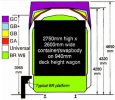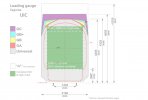Your comment got me looking into it, after a bit of googling I managed to find two images which I have managed to superimpose to the same scale, its not 100% accurate, but shows the problem we have in the UK, we cant go out or up.
Red is UK C1, Blue is pre 1987 Japanese 3'6", Grey is post 1987 Japanese, and green is Japanese 4'8" high speed. current Japanese loading gauge is bigger all round, earlier one (which still applies on some line as far as I can work out) is very similar to UK, except the bottom quarter, which as you say is a lot more generous
View attachment 99676
Would be interesting to have a visual representation of what we'd need for something like the French or German DD trains on our network



